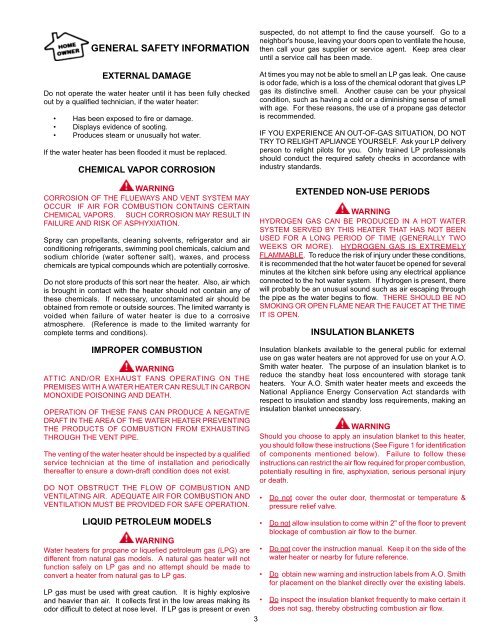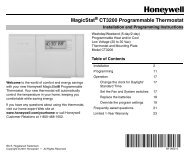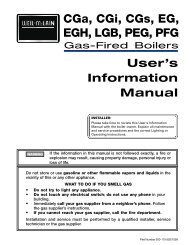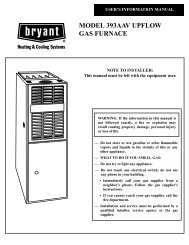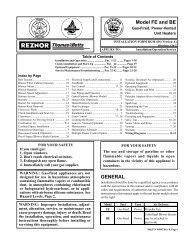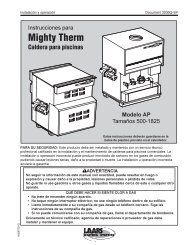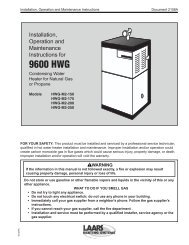Power Vented Gas Models FPSH/FPCR/FPST with ... - Geisel
Power Vented Gas Models FPSH/FPCR/FPST with ... - Geisel
Power Vented Gas Models FPSH/FPCR/FPST with ... - Geisel
Create successful ePaper yourself
Turn your PDF publications into a flip-book with our unique Google optimized e-Paper software.
GENERAL SAFETY INFORMATION<br />
EXTERNAL DAMAGE<br />
Do not operate the water heater until it has been fully checked<br />
out by a qualified technician, if the water heater:<br />
Has been exposed to fire or damage.<br />
Displays evidence of sooting.<br />
Produces steam or unusually hot water.<br />
If the water heater has been flooded it must be replaced.<br />
CHEMICAL VAPOR CORROSION<br />
WARNING<br />
CORROSION OF THE FLUEWAYS AND VENT SYSTEM MAY<br />
OCCUR IF AIR FOR COMBUSTION CONTAINS CERTAIN<br />
CHEMICAL VAPORS. SUCH CORROSION MAY RESULT IN<br />
FAILURE AND RISK OF ASPHYXIATION.<br />
Spray can propellants, cleaning solvents, refrigerator and air<br />
conditioning refrigerants, swimming pool chemicals, calcium and<br />
sodium chloride (water softener salt), waxes, and process<br />
chemicals are typical compounds which are potentially corrosive.<br />
Do not store products of this sort near the heater. Also, air which<br />
is brought in contact <strong>with</strong> the heater should not contain any of<br />
these chemicals. If necessary, uncontaminated air should be<br />
obtained from remote or outside sources. The limited warranty is<br />
voided when failure of water heater is due to a corrosive<br />
atmosphere. (Reference is made to the limited warranty for<br />
complete terms and conditions).<br />
IMPROPER COMBUSTION<br />
WARNING<br />
ATTIC AND/OR EXHAUST FANS OPERATING ON THE<br />
PREMISES WITH A WATER HEATER CAN RESULT IN CARBON<br />
MONOXIDE POISONING AND DEATH.<br />
OPERATION OF THESE FANS CAN PRODUCE A NEGATIVE<br />
DRAFT IN THE AREA OF THE WATER HEATER PREVENTING<br />
THE PRODUCTS OF COMBUSTION FROM EXHAUSTING<br />
THROUGH THE VENT PIPE.<br />
The venting of the water heater should be inspected by a qualified<br />
service technician at the time of installation and periodically<br />
thereafter to ensure a down-draft condition does not exist.<br />
DO NOT OBSTRUCT THE FLOW OF COMBUSTION AND<br />
VENTILATING AIR. ADEQUATE AIR FOR COMBUSTION AND<br />
VENTILATION MUST BE PROVIDED FOR SAFE OPERATION.<br />
LIQUID PETROLEUM MODELS<br />
WARNING<br />
Water heaters for propane or liquefied petroleum gas (LPG) are<br />
different from natural gas models. A natural gas heater will not<br />
function safely on LP gas and no attempt should be made to<br />
convert a heater from natural gas to LP gas.<br />
LP gas must be used <strong>with</strong> great caution. It is highly explosive<br />
and heavier than air. It collects first in the low areas making its<br />
odor difficult to detect at nose level. If LP gas is present or even<br />
3<br />
suspected, do not attempt to find the cause yourself. Go to a<br />
neighbor's house, leaving your doors open to ventilate the house,<br />
then call your gas supplier or service agent. Keep area clear<br />
until a service call has been made.<br />
At times you may not be able to smell an LP gas leak. One cause<br />
is odor fade, which is a loss of the chemical odorant that gives LP<br />
gas its distinctive smell. Another cause can be your physical<br />
condition, such as having a cold or a diminishing sense of smell<br />
<strong>with</strong> age. For these reasons, the use of a propane gas detector<br />
is recommended.<br />
IF YOU EXPERIENCE AN OUT-OF-GAS SITUATION, DO NOT<br />
TRY TO RELIGHT APLIANCE YOURSELF. Ask your LP delivery<br />
person to relight pilots for you. Only trained LP professionals<br />
should conduct the required safety checks in accordance <strong>with</strong><br />
industry standards.<br />
EXTENDED NON-USE PERIODS<br />
WARNING<br />
HYDROGEN GAS CAN BE PRODUCED IN A HOT WATER<br />
SYSTEM SERVED BY THIS HEATER THAT HAS NOT BEEN<br />
USED FOR A LONG PERIOD OF TIME (GENERALLY TWO<br />
WEEKS OR MORE). HYDROGEN GAS IS EXTREMELY<br />
FLAMMABLE. To reduce the risk of injury under these conditions,<br />
it is recommended that the hot water faucet be opened for several<br />
minutes at the kitchen sink before using any electrical appliance<br />
connected to the hot water system. If hydrogen is present, there<br />
will probably be an unusual sound such as air escaping through<br />
the pipe as the water begins to flow. THERE SHOULD BE NO<br />
SMOKING OR OPEN FLAME NEAR THE FAUCET AT THE TIME<br />
IT IS OPEN.<br />
INSULATION BLANKETS<br />
Insulation blankets available to the general public for external<br />
use on gas water heaters are not approved for use on your A.O.<br />
Smith water heater. The purpose of an insulation blanket is to<br />
reduce the standby heat loss encountered <strong>with</strong> storage tank<br />
heaters. Your A.O. Smith water heater meets and exceeds the<br />
National Appliance Energy Conservation Act standards <strong>with</strong><br />
respect to insulation and standby loss requirements, making an<br />
insulation blanket unnecessary.<br />
WARNING<br />
Should you choose to apply an insulation blanket to this heater,<br />
you should follow these instructions (See Figure 1 for identification<br />
of components mentioned below). Failure to follow these<br />
instructions can restrict the air flow required for proper combustion,<br />
potentially resulting in fire, asphyxiation, serious personal injury<br />
or death.<br />
• Do not cover the outer door, thermostat or temperature &<br />
pressure relief valve.<br />
Do not allow insulation to come <strong>with</strong>in 2" of the floor to prevent<br />
blockage of combustion air flow to the burner.<br />
Do not cover the instruction manual. Keep it on the side of the<br />
water heater or nearby for future reference.<br />
Do obtain new warning and instruction labels from A.O. Smith<br />
for placement on the blanket directly over the existing labels.<br />
Do inspect the insulation blanket frequently to make certain it<br />
does not sag, thereby obstructing combustion air flow.


